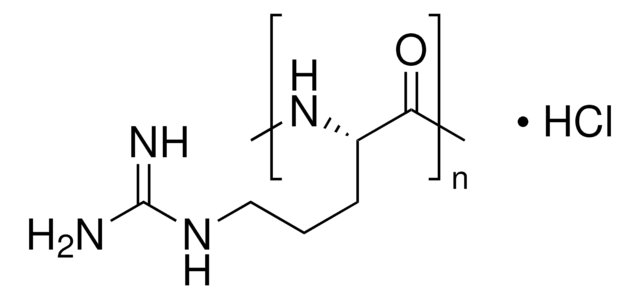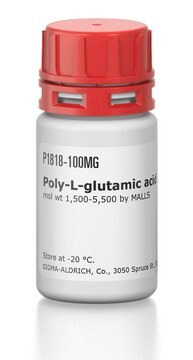P6516
Poli-L-lisina hydrobromide
suitable for cell culture, Mol wt ≤15,000 by MALLS
Sinónimos:
L-Lysine homopolymer hydrobromide
About This Item
Productos recomendados
product name
Poli-L-lisina hydrobromide, mol wt 4,000-15,000 by viscosity
form
solid
Quality Level
mol wt
≤15,000 by MALLS
4,000-15,000 by viscosity
greener alternative product score
old score: 51
new score: 43
Find out more about DOZN™ Scoring
greener alternative product characteristics
Designing Safer Chemicals
Safer Solvents and Auxiliaries
Reduce Derivatives
Learn more about the Principles of Green Chemistry.
sustainability
Greener Alternative Product
technique(s)
cell culture | mammalian: suitable
color
white to off-white
application(s)
cell analysis
greener alternative category
storage temp.
−20°C
SMILES string
Cl.NCCCCC(N)C(O)=O
InChI
1S/C18H38N6O4/c19-10-4-1-7-13(22)16(25)23-14(8-2-5-11-20)17(26)24-15(18(27)28)9-3-6-12-21/h13-15H,1-12,19-22H2,(H,23,25)(H,24,26)(H,27,28)/t13-,14-,15-/m0/s1
InChI key
WBSCNDJQPKSPII-KKUMJFAQSA-N
¿Está buscando productos similares? Visita Guía de comparación de productos
General description
Application
- as a component of polyplexes and in DNA condensation experiments
- for coating circular mica disks for atomic force microscopy studies and SuperFrost glass slides for immunofluorescence studies of in HL-60 cells
- as a reference standard for generating calibration curve for the quantification of ε- Poly-L-lysine
Biochem/physiol Actions
Components
Caution
Preparation Note
Storage Class
11 - Combustible Solids
wgk_germany
WGK 3
flash_point_f
Not applicable
flash_point_c
Not applicable
ppe
Eyeshields, Gloves, type N95 (US)
Certificados de análisis (COA)
Busque Certificados de análisis (COA) introduciendo el número de lote del producto. Los números de lote se encuentran en la etiqueta del producto después de las palabras «Lot» o «Batch»
¿Ya tiene este producto?
Encuentre la documentación para los productos que ha comprado recientemente en la Biblioteca de documentos.
Los clientes también vieron
Artículos
Kanjiro Miyata (The University of Tokyo, Japan) provides insights on the rational design of polymeric materials for “smart” oligonucleotide delivery.
Nuestro equipo de científicos tiene experiencia en todas las áreas de investigación: Ciencias de la vida, Ciencia de los materiales, Síntesis química, Cromatografía, Analítica y muchas otras.
Póngase en contacto con el Servicio técnico





